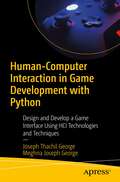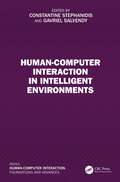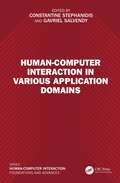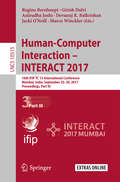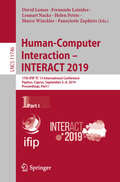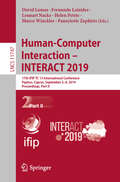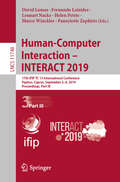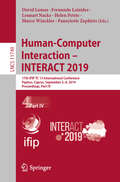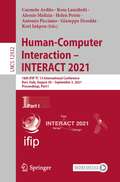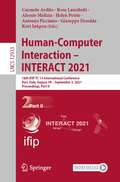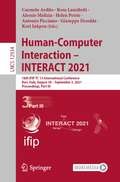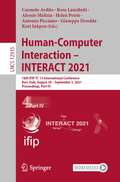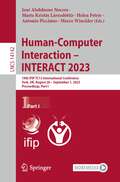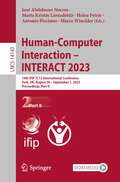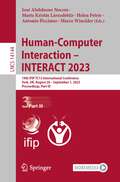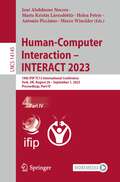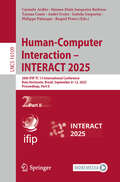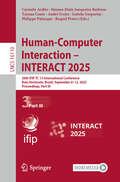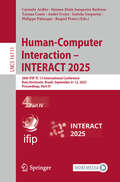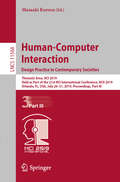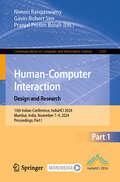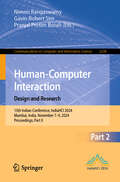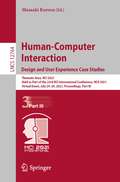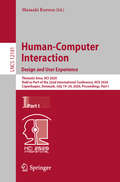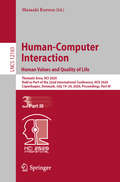- Table View
- List View
Human-Computer Interaction in Game Development with Python: Design and Develop a Game Interface Using HCI Technologies and Techniques
by Joseph Thachil George Meghna Joseph GeorgeDeepen your understanding of human-computer interaction (HCI) in game development and learn how to develop video games that grab players and don't let them go. This book explores HCI design in computer games to maximize collaborative and interactive functions. You'll first gain a basic introduction to fundamental concepts and practices of HCI before diving into the fundamental concepts of game interface design and technology. You'll learn how to design a gaming interface through practical examples using Python. This is followed by a brief look at how HCI can offer immersive gaming experiences for players and a review of key elements such as interface, usability, user-centered design, and user interface in terms of efficacy. You will also learn how to implement usability aspects in gaming interfaces with examples using Python. Additionally, the book discusses major challenges that game publishers and developers face, and how they can be resolved using HCI techniques. The question of playability is reviewed throughout the game production process. After working through this book's practical examples, you'll have the knowledge required to begin developing compelling, can't-put-the-controller down games of your own. What You'll LearnMaster HCI tools and methodologies Understand the concept of HCI strategies in the game development cycleDevelop a game in Python using the HCI approachUtilize gamification techniques in Human-Computer InteractionGrasp concepts of usability, user experience and user-centered design processes and their application Who This Book Is ForProgrammers, engineers, and students interested in creating and implementing computer games using HCI technologies. Prior experience with game development is recommended.
Human-Computer Interaction in Intelligent Environments: 5th International Conference, Uahci 2009, Held As Part Of Hci International 2009, San Diego, Ca, Usa, July 19-24, 2009. Proceedings, Part Ii (Lecture Notes In Computer Science Ser. #5615)
by Gavriel Salvendy Constantine StephanidisThis book offers readers a holistic understanding of intelligent environments, encompassingtheir definition, design, interaction paradigms, the role of Artificial Intelligence (AI), and theassociated broader philosophical and procedural aspects. Elaborates on AI research and the creation of intelligent environments. Zooms in on designing interactions with the IoT, intelligent agents and robots. Discusses overarching topics for the design of intelligent environments, including user interface adaptation, design for all, sustainability, cybersecurity, privacy and trust. Provides insights into the intricacies of various intelligent environment contexts, such as in automotive, urban interfaces, smart cities and beyond. This book has been written for individuals interested in Human-Computer Interaction research and applications.
Human-Computer Interaction in Various Application Domains
by Gavriel Salvendy Constantine StephanidisHuman-Computer Interaction (HCI) is a multidisciplinary research and applied field targeted to studying people interacting with information technology and designing usable and efficient systems for them. This book outlines the state‑of‑the‑art of HCI research in the respective domain such as health, games, transportation, industry, and entertainment.This book Bridges the gap between theory and practice by presenting how to apply HCI methods and tools in specific domains. Offers concrete examples of HCI use in real-world situations. Presents case-specific best practices, tips, and tricks. Includes chapters that are well-studied and purposefully selected, representing important theoretical, practical, and research areas in HCI. Includes domains ranging from the roots and the classic approaches of human-computer interaction to contemporary advancements. This book is a fascinating read for individuals interested in Human-Computer Interaction research and applications.
Human-Computer Interaction – INTERACT 2017: 16th IFIP TC 13 International Conference, Mumbai, India, September 25–29, 2017, Proceedings, Part III (Lecture Notes in Computer Science #10515)
by Regina Bernhaupt Marco Winckler Girish Dalvi Anirudha Joshi Devanuj K. Balkrishan Jacki O'NeillThe four-volume set LNCS 10513—10516 constitutes the proceedings of the 16th IFIP TC 13 International Conference on Human-Computer Interaction, INTERACT 2017, held in Mumbai, India, in September 2017. The total of 68 papers presented in these books was carefully reviewed and selected from 221 submissions. The contributions are organized in topical sections named: Part I: adaptive design and mobile applications; aging and disabilities; assistive technology for blind users; audience engagement; co-design studies; cultural differences and communication technology; design rationale and camera-control. Part II: digital inclusion; games; human perception, cognition and behavior; information on demand, on the move, and gesture interaction; interaction at the workplace; interaction with children. Part III: mediated communication in health; methods and tools for user interface evaluation; multi-touch interaction; new interaction techniques; personalization and visualization; persuasive technology and rehabilitation; and pointing and target selection.
Human-Computer Interaction – INTERACT 2019: 17th IFIP TC 13 International Conference, Paphos, Cyprus, September 2–6, 2019, Proceedings, Part I (Lecture Notes in Computer Science #11746)
by David Lamas Marco Winckler Panayiotis Zaphiris Helen Petrie Fernando Loizides Lennart NackeThe four-volume set LNCS 11746–11749 constitutes the proceedings of the 17th IFIP TC 13 International Conference on Human-Computer Interaction, INTERACT 2019, held in Paphos, Cyprus, in September 2019. The total of 111 full papers presented together with 55 short papers and 48 other papers in these books was carefully reviewed and selected from 385 submissions. The contributions are organized in topical sections named: Part I: accessibility design principles; assistive technology for cognition and neurodevelopment disorders; assistive technology for mobility and rehabilitation; assistive technology for visually impaired; co-design and design methods; crowdsourcing and collaborative work; cyber security and e-voting systems; design methods; design principles for safety/critical systems. Part II: e-commerce; education and HCI curriculum I; education and HCI curriculum II; eye-gaze interaction; games and gamification; human-robot interaction and 3D interaction; information visualization; information visualization and augmented reality; interaction design for culture and development I. Part III: interaction design for culture and development II; interaction design for culture and development III; interaction in public spaces; interaction techniques for writing and drawing; methods for user studies; mobile HCI; personalization and recommender systems; pointing, touch, gesture and speech-based interaction techniques; social networks and social media interaction. Part IV: user modelling and user studies; user experience; users’ emotions, feelings and perception; virtual and augmented reality I; virtual and augmented reality II; wearable and tangible interaction; courses; demonstrations and installations; industry case studies; interactive posters; panels; workshops.The chapter ‘Analyzing Accessibility Barriers Using Cost-Benefit Analysis to Design Reliable Navigation Services for Wheelchair Users’ is open access under a CC BY 4.0 license.
Human-Computer Interaction – INTERACT 2019: 17th IFIP TC 13 International Conference, Paphos, Cyprus, September 2–6, 2019, Proceedings, Part II (Lecture Notes in Computer Science #11747)
by David Lamas Marco Winckler Panayiotis Zaphiris Helen Petrie Fernando Loizides Lennart NackeThe four-volume set LNCS 11746–11749 constitutes the proceedings of the 17th IFIP TC 13 International Conference on Human-Computer Interaction, INTERACT 2019, held in Paphos, Cyprus, in September 2019.The total of 111 full papers presented together with 55 short papers and 48 other papers in these books was carefully reviewed and selected from 385 submissions. The contributions are organized in topical sections named:Part I: accessibility design principles; assistive technology for cognition and neurodevelopment disorders; assistive technology for mobility and rehabilitation; assistive technology for visually impaired; co-design and design methods; crowdsourcing and collaborative work; cyber security and e-voting systems; design methods; design principles for safety/critical systems. Part II: e-commerce; education and HCI curriculum I; education and HCI curriculum II; eye-gaze interaction; games and gamification; human-robot interaction and 3D interaction; information visualization; information visualization and augmented reality; interaction design for culture and development I. Part III: interaction design for culture and development II; interaction design for culture and development III; interaction in public spaces; interaction techniques for writing and drawing; methods for user studies; mobile HCI; personalization and recommender systems; pointing, touch, gesture and speech-based interaction techniques; social networks and social media interaction. Part IV: user modelling and user studies; user experience; users’ emotions, feelings and perception; virtual and augmented reality I; virtual and augmented reality II; wearable and tangible interaction; courses; demonstrations and installations; industry case studies; interactive posters; panels; workshops.
Human-Computer Interaction – INTERACT 2019: 17th IFIP TC 13 International Conference, Paphos, Cyprus, September 2–6, 2019, Proceedings, Part III (Lecture Notes in Computer Science #11748)
by David Lamas Marco Winckler Panayiotis Zaphiris Helen Petrie Fernando Loizides Lennart NackeThe four-volume set LNCS 11746–11749 constitutes the proceedings of the 17th IFIP TC 13 International Conference on Human-Computer Interaction, INTERACT 2019, held in Paphos, Cyprus, in September 2019.The total of 111 full papers presented together with 55 short papers and 48 other papers in these books was carefully reviewed and selected from 385 submissions. The contributions are organized in topical sections named:Part I: accessibility design principles; assistive technology for cognition and neurodevelopment disorders; assistive technology for mobility and rehabilitation; assistive technology for visually impaired; co-design and design methods; crowdsourcing and collaborative work; cyber security and e-voting systems; design methods; design principles for safety/critical systems. Part II: e-commerce; education and HCI curriculum I; education and HCI curriculum II; eye-gaze interaction; games and gamification; human-robot interaction and 3D interaction; information visualization; information visualization and augmented reality; interaction design for culture and development I. Part III: interaction design for culture and development II; interaction design for culture and development III; interaction in public spaces; interaction techniques for writing and drawing; methods for user studies; mobile HCI; personalization and recommender systems; pointing, touch, gesture and speech-based interaction techniques; social networks and social media interaction. Part IV: user modelling and user studies; user experience; users’ emotions, feelings and perception; virtual and augmented reality I; virtual and augmented reality II; wearable and tangible interaction; courses; demonstrations and installations; industry case studies; interactive posters; panels; workshops.
Human-Computer Interaction – INTERACT 2019: 17th IFIP TC 13 International Conference, Paphos, Cyprus, September 2–6, 2019, Proceedings, Part IV (Lecture Notes in Computer Science #11749)
by David Lamas Marco Winckler Panayiotis Zaphiris Helen Petrie Fernando Loizides Lennart NackeThe four-volume set LNCS 11746–11749 constitutes the proceedings of the 17th IFIP TC 13 International Conference on Human-Computer Interaction, INTERACT 2019, held in Paphos, Cyprus, in September 2019.The total of 111 full papers presented together with 55 short papers and 48 other papers in these books was carefully reviewed and selected from 385 submissions. The contributions are organized in topical sections named:Part I: accessibility design principles; assistive technology for cognition and neurodevelopment disorders; assistive technology for mobility and rehabilitation; assistive technology for visually impaired; co-design and design methods; crowdsourcing and collaborative work; cyber security and e-voting systems; design methods; design principles for safety/critical systems. Part II: e-commerce; education and HCI curriculum I; education and HCI curriculum II; eye-gaze interaction; games and gamification; human-robot interaction and 3D interaction; information visualization; information visualization and augmented reality; interaction design for culture and development I. Part III: interaction design for culture and development II; interaction design for culture and development III; interaction in public spaces; interaction techniques for writing and drawing; methods for user studies; mobile HCI; personalization and recommender systems; pointing, touch, gesture and speech-based interaction techniques; social networks and social media interaction. Part IV: user modelling and user studies; user experience; users’ emotions, feelings and perception; virtual and augmented reality I; virtual and augmented reality II; wearable and tangible interaction; courses; demonstrations and installations; industry case studies; interactive posters; panels; workshops.The chapter ‘Experiencing Materialized Reading: Individuals’ Encounters with Books’ is open access under a CC BY 4.0 license at link.springer.com.The chapter ‘What Is Beautiful Continues to Be Good: People Images and Algorithmic Inferences on Physical Attractiveness’ is open access under a CC BY 4.0 license at link.springer.com.
Human-Computer Interaction – INTERACT 2021: 18th IFIP TC 13 International Conference, Bari, Italy, August 30 – September 3, 2021, Proceedings, Part I (Lecture Notes in Computer Science #12932)
by Helen Petrie Alessio Malizia Carmelo Ardito Rosa Lanzilotti Antonio Piccinno Giuseppe Desolda Kori InkpenThe five-volume set LNCS 12932-12936 constitutes the proceedings of the 18th IFIP TC 13 International Conference on Human-Computer Interaction, INTERACT 2021, held in Bari, Italy, in August/September 2021.The total of 105 full papers presented together with 72 short papers and 70 other papers in these books was carefully reviewed and selected from 680 submissions. The contributions are organized in topical sections named: Part I: affective computing; assistive technology for cognition and neurodevelopment disorders; assistive technology for mobility and rehabilitation; assistive technology for visually impaired; augmented reality; computer supported cooperative work. Part II: COVID-19 & HCI; croudsourcing methods in HCI; design for automotive interfaces; design methods; designing for smart devices & IoT; designing for the elderly and accessibility; education and HCI; experiencing sound and music technologies; explainable AI. Part III: games and gamification; gesture interaction; human-centered AI; human-centered development of sustainable technology; human-robot interaction; information visualization; interactive design and cultural development. Part IV: interaction techniques; interaction with conversational agents; interaction with mobile devices; methods for user studies; personalization and recommender systems; social networks and social media; tangible interaction; usable security. Part V: user studies; virtual reality; courses; industrial experiences; interactive demos; panels; posters; workshops. The chapter ‘Stress Out: Translating Real-World Stressors into Audio-Visual Stress Cues in VR for Police Training’ is open access under a CC BY 4.0 license at link.springer.com. The chapter ‘WhatsApp in Politics?! Collaborative Tools Shifting Boundaries’ is open access under a CC BY 4.0 license at link.springer.com.
Human-Computer Interaction – INTERACT 2021: 18th IFIP TC 13 International Conference, Bari, Italy, August 30 – September 3, 2021, Proceedings, Part II (Lecture Notes in Computer Science #12933)
by Helen Petrie Alessio Malizia Carmelo Ardito Rosa Lanzilotti Antonio Piccinno Giuseppe Desolda Kori InkpenThe five-volume set LNCS 12932-12936 constitutes the proceedings of the 18th IFIP TC 13 International Conference on Human-Computer Interaction, INTERACT 2021, held in Bari, Italy, in August/September 2021.The total of 105 full papers presented together with 72 short papers and 70 other papers in these books was carefully reviewed and selected from 680 submissions. The contributions are organized in topical sections named: Part I: affective computing; assistive technology for cognition and neurodevelopment disorders; assistive technology for mobility and rehabilitation; assistive technology for visually impaired; augmented reality; computer supported cooperative work. Part II: COVID-19 & HCI; croudsourcing methods in HCI; design for automotive interfaces; design methods; designing for smart devices & IoT; designing for the elderly and accessibility; education and HCI; experiencing sound and music technologies; explainable AI. Part III: games and gamification; gesture interaction; human-centered AI; human-centered development of sustainable technology; human-robot interaction; information visualization; interactive design and cultural development. Part IV: interaction techniques; interaction with conversational agents; interaction with mobile devices; methods for user studies; personalization and recommender systems; social networks and social media; tangible interaction; usable security. Part V: user studies; virtual reality; courses; industrial experiences; interactive demos; panels; posters; workshops. The chapter ‘Stress Out: Translating Real-World Stressors into Audio-Visual Stress Cues in VR for Police Training’ is open access under a CC BY 4.0 license at link.springer.com. The chapter ‘WhatsApp in Politics?! Collaborative Tools Shifting Boundaries’ is open access under a CC BY 4.0 license at link.springer.com.
Human-Computer Interaction – INTERACT 2021: 18th IFIP TC 13 International Conference, Bari, Italy, August 30 – September 3, 2021, Proceedings, Part III (Lecture Notes in Computer Science #12934)
by Helen Petrie Alessio Malizia Carmelo Ardito Rosa Lanzilotti Antonio Piccinno Giuseppe Desolda Kori InkpenThe five-volume set LNCS 12932-12936 constitutes the proceedings of the 18th IFIP TC 13 International Conference on Human-Computer Interaction, INTERACT 2021, held in Bari, Italy, in August/September 2021.The total of 105 full papers presented together with 72 short papers and 70 other papers in these books was carefully reviewed and selected from 680 submissions. The contributions are organized in topical sections named: Part I: affective computing; assistive technology for cognition and neurodevelopment disorders; assistive technology for mobility and rehabilitation; assistive technology for visually impaired; augmented reality; computer supported cooperative work. Part II: COVID-19 & HCI; croudsourcing methods in HCI; design for automotive interfaces; design methods; designing for smart devices & IoT; designing for the elderly and accessibility; education and HCI; experiencing sound and music technologies; explainable AI. Part III: games and gamification; gesture interaction; human-centered AI; human-centered development of sustainable technology; human-robot interaction; information visualization; interactive design and cultural development. Part IV: interaction techniques; interaction with conversational agents; interaction with mobile devices; methods for user studies; personalization and recommender systems; social networks and social media; tangible interaction; usable security. Part V: user studies; virtual reality; courses; industrial experiences; interactive demos; panels; posters; workshops. The chapter ‘Stress Out: Translating Real-World Stressors into Audio-Visual Stress Cues in VR for Police Training’ is open access under a CC BY 4.0 license at link.springer.com. The chapter ‘WhatsApp in Politics?! Collaborative Tools Shifting Boundaries’ is open access under a CC BY 4.0 license at link.springer.com.
Human-Computer Interaction – INTERACT 2021: 18th IFIP TC 13 International Conference, Bari, Italy, August 30 – September 3, 2021, Proceedings, Part IV (Lecture Notes in Computer Science #12935)
by Helen Petrie Alessio Malizia Carmelo Ardito Rosa Lanzilotti Antonio Piccinno Giuseppe Desolda Kori InkpenThe five-volume set LNCS 12932-12936 constitutes the proceedings of the 18th IFIP TC 13 International Conference on Human-Computer Interaction, INTERACT 2021, held in Bari, Italy, in August/September 2021.The total of 105 full papers presented together with 72 short papers and 70 other papers in these books was carefully reviewed and selected from 680 submissions. The contributions are organized in topical sections named: Part I: affective computing; assistive technology for cognition and neurodevelopment disorders; assistive technology for mobility and rehabilitation; assistive technology for visually impaired; augmented reality; computer supported cooperative work. Part II: COVID-19 & HCI; croudsourcing methods in HCI; design for automotive interfaces; design methods; designing for smart devices & IoT; designing for the elderly and accessibility; education and HCI; experiencing sound and music technologies; explainable AI. Part III: games and gamification; gesture interaction; human-centered AI; human-centered development of sustainable technology; human-robot interaction; information visualization; interactive design and cultural development. Part IV: interaction techniques; interaction with conversational agents; interaction with mobile devices; methods for user studies; personalization and recommender systems; social networks and social media; tangible interaction; usable security. Part V: user studies; virtual reality; courses; industrial experiences; interactive demos; panels; posters; workshops. The chapter ‘Stress Out: Translating Real-World Stressors into Audio-Visual Stress Cues in VR for Police Training’ is open access under a CC BY 4.0 license at link.springer.com. The chapter ‘WhatsApp in Politics?! Collaborative Tools Shifting Boundaries’ is open access under a CC BY 4.0 license at link.springer.com.
Human-Computer Interaction – INTERACT 2023: 19th IFIP TC13 International Conference, York, UK, August 28 – September 1, 2023, Proceedings, Part I (Lecture Notes in Computer Science #14142)
by José Abdelnour Nocera Marco Winckler Helen Petrie Marta Kristín Lárusdóttir Antonio PiccinnoThe four-volume set LNCS 14442 -14445 constitutes the proceedings of the 19th IFIP TC 13 International Conference on Human-Computer Interaction, INTERACT 2023, held in York, UK, in August/September 2023. The 71 full papers and 58 short papers included in this book were carefully reviewed and selected from 406 submissions. They were organized in topical sections as follows: 3D Interaction; Accessibility; Accessibility and Aging; Accessibility for Auditory/Hearing Disabilities; Co-Design; Cybersecurity and Trust; Data Physicalisation and Cross-device; Eye-Free, Gesture Interaction and Sign Language; Haptic interaction and Healthcare applications; Self-Monitoring; Human-Robot Interaction; Information Visualization; Information Visualization and 3D Interaction; Interacting with Children; Interaction with Conversational Agents; Methodologies for HCI; Model-Based UI Design and Testing; Montion Sickness, Stress and Risk perception in 3D Environments and Multisensory interaction; VR experiences; Natural Language Processing and AI Explainability; Online Collaboration and Cooperative work; Recommendation Systems and AI Explainability; Social AI; Social and Ubiquitous Computing; Social Media and Digital Learning; Understanding Users and Privacy Issues; User movement and 3D Environments; User Self-Report; User Studies; User Studies, Eye-Tracking, and Physiological Data; Virtual Reality; Virtual Reality and Training; Courses; Industrial Experiences; Interactive Demonstrations; Keynotes; Panels; Posters; and Workshops.
Human-Computer Interaction – INTERACT 2023: 19th IFIP TC13 International Conference, York, UK, August 28 – September 1, 2023, Proceedings, Part II (Lecture Notes in Computer Science #14143)
by José Abdelnour Nocera Marco Winckler Helen Petrie Marta Kristín Lárusdóttir Antonio PiccinnoThe four-volume set LNCS 14442 -14445 constitutes the proceedings of the 19th IFIP TC 13 International Conference on Human-Computer Interaction, INTERACT 2023, held in York, UK, in August/September 2023. The 71 full papers and 58 short papers included in this book were carefully reviewed and selected from 406 submissions. They were organized in topical sections as follows: 3D Interaction; Accessibility; Accessibility and Aging; Accessibility for Auditory/Hearing Disabilities; Co-Design; Cybersecurity and Trust; Data Physicalisation and Cross-device; Eye-Free, Gesture Interaction and Sign Language; Haptic interaction and Healthcare applications; Self-Monitoring; Human-Robot Interaction; Information Visualization; Information Visualization and 3D Interaction; Interacting with Children; Interaction with Conversational Agents; Methodologies for HCI; Model-Based UI Design and Testing; Montion Sickness, Stress and Risk perception in 3D Environments and Multisensory interaction; VR experiences; Natural Language Processing and AI Explainability; Online Collaboration and Cooperative work; Recommendation Systems and AI Explainability; Social AI; Social and Ubiquitous Computing; Social Media and Digital Learning; Understanding Users and Privacy Issues; User movement and 3D Environments; User Self-Report; User Studies; User Studies, Eye-Tracking, and Physiological Data; Virtual Reality; Virtual Reality and Training; Courses; Industrial Experiences; Interactive Demonstrations; Keynotes; Panels; Posters; and Workshops.
Human-Computer Interaction – INTERACT 2023: 19th IFIP TC13 International Conference, York, UK, August 28 – September 1, 2023, Proceedings, Part III (Lecture Notes in Computer Science #14144)
by José Abdelnour Nocera Marco Winckler Helen Petrie Marta Kristín Lárusdóttir Antonio PiccinnoThe four-volume set LNCS 14442 -14445 constitutes the proceedings of the 19th IFIP TC 13 International Conference on Human-Computer Interaction, INTERACT 2023, held in York, UK, in August/September 2023. The 71 full papers and 58 short papers included in this book were carefully reviewed and selected from 406 submissions. They were organized in topical sections as follows: 3D Interaction; Accessibility; Accessibility and Aging; Accessibility for Auditory/Hearing Disabilities; Co-Design; Cybersecurity and Trust; Data Physicalisation and Cross-device; Eye-Free, Gesture Interaction and Sign Language; Haptic interaction and Healthcare applications; Self-Monitoring; Human-Robot Interaction; Information Visualization; Information Visualization and 3D Interaction; Interacting with Children; Interaction with Conversational Agents; Methodologies for HCI; Model-Based UI Design and Testing; Montion Sickness, Stress and Risk perception in 3D Environments and Multisensory interaction; VR experiences; Natural Language Processing and AI Explainability; Online Collaboration and Cooperative work; Recommendation Systems and AI Explainability; Social AI; Social and Ubiquitous Computing; Social Media and Digital Learning; Understanding Users and Privacy Issues; User movement and 3D Environments; User Self-Report; User Studies; User Studies, Eye-Tracking, and Physiological Data; Virtual Reality; Virtual Reality and Training; Courses; Industrial Experiences; Interactive Demonstrations; Keynotes; Panels; Posters; and Workshops.
Human-Computer Interaction – INTERACT 2023: 19th IFIP TC13 International Conference, York, UK, August 28 – September 1, 2023, Proceedings, Part IV (Lecture Notes in Computer Science #14145)
by José Abdelnour Nocera Marco Winckler Helen Petrie Marta Kristín Lárusdóttir Antonio PiccinnoThe four-volume set LNCS 14442 -14445 constitutes the proceedings of the 19th IFIP TC 13 International Conference on Human-Computer Interaction, INTERACT 2023, held in York, UK, in August/September 2023. The 71 full papers and 58 short papers included in this book were carefully reviewed and selected from 406 submissions. They were organized in topical sections as follows: 3D Interaction; Accessibility; Accessibility and Aging; Accessibility for Auditory/Hearing Disabilities; Co-Design; Cybersecurity and Trust; Data Physicalisation and Cross-device; Eye-Free, Gesture Interaction and Sign Language; Haptic interaction and Healthcare applications; Self-Monitoring; Human-Robot Interaction; Information Visualization; Information Visualization and 3D Interaction; Interacting with Children; Interaction with Conversational Agents; Methodologies for HCI; Model-Based UI Design and Testing; Montion Sickness, Stress and Risk perception in 3D Environments and Multisensory interaction; VR experiences; Natural Language Processing and AI Explainability; Online Collaboration and Cooperative work; Recommendation Systems and AI Explainability; Social AI; Social and Ubiquitous Computing; Social Media and Digital Learning; Understanding Users and Privacy Issues; User movement and 3D Environments; User Self-Report; User Studies; User Studies, Eye-Tracking, and Physiological Data; Virtual Reality; Virtual Reality and Training; Courses; Industrial Experiences; Interactive Demonstrations; Keynotes; Panels; Posters; and Workshops.
Human-Computer Interaction – INTERACT 2025: 20th IFIP TC 13 International Conference, Belo Horizonte, Brazil, September 8–12, 2025, Proceedings, Part II (Lecture Notes in Computer Science #16109)
by Philippe Palanque Simone Diniz Junqueira Barbosa Carmelo Ardito André Freire Tayana Conte Isabela Gasparini Raquel PratesThis four-volume set LNCS 16108-16111 constitutes the proceedings of the 20th IFIP TC 13 International Conference on Human-Computer Interaction, INTERACT 2025, held in Belo Horizonte, Brazil, during September 8–12, 2025. The 69 full papers, 34 short papers and 79 papers of other types included in this book were carefully reviewed and selected from 330 submissions. They were organized in topical sections as follows: Part I: Accessibility; Adaptive and AI-Powered Learning Systems; Aesthetics in HCI; Affective HCI and Emotion; and Augmented Reality. Part II: Computer-Supported Cooperative Work; Context-Dependent Systems; Design and Evaluation in Smart and Ubiquitous Contexts; Designing for Identity, Safety, and Cultural Values; Emotionally-Informed Design; HCD for Mission-Critical Systems; HCI in Formal and Inclusive Learning Contexts; HCI in Healthcare and Wellbeing; and Human-AI Interaction. Part III: Interaction with Small or Large Displays; Learning Tools and Intelligent Tutoring; Methodologies for HCI; Multimodal Assistive Interfaces; Usability Evaluation Methods; Usable Privacy and Security. Part IV: Courses; Industrial Experiences; Interactive Demonstrations; Panels; Posters; and Workshops.
Human-Computer Interaction – INTERACT 2025: 20th IFIP TC 13 International Conference, Belo Horizonte, Brazil, September 8–12, 2025, Proceedings, Part III (Lecture Notes in Computer Science #16110)
by Philippe Palanque Simone Diniz Junqueira Barbosa Carmelo Ardito André Freire Tayana Conte Isabela Gasparini Raquel PratesThis four-volume set LNCS 16108-16111 constitutes the proceedings of the 20th IFIP TC 13 International Conference on Human-Computer Interaction, INTERACT 2025, held in Belo Horizonte, Brazil, during September 8–12, 2025. The 69 full papers, 34 short papers and 79 papers of other types included in this book were carefully reviewed and selected from 330 submissions. They were organized in topical sections as follows: Part I: Accessibility; Adaptive and AI-Powered Learning Systems; Aesthetics in HCI; Affective HCI and Emotion; and Augmented Reality. Part II: Computer-Supported Cooperative Work; Context-Dependent Systems; Design and Evaluation in Smart and Ubiquitous Contexts; Designing for Identity, Safety, and Cultural Values; Emotionally-Informed Design; HCD for Mission-Critical Systems; HCI in Formal and Inclusive Learning Contexts; HCI in Healthcare and Wellbeing; and Human-AI Interaction. Part III: Interaction with Small or Large Displays; Learning Tools and Intelligent Tutoring; Methodologies for HCI; Multimodal Assistive Interfaces; Usability Evaluation Methods; Usable Privacy and Security. Part IV: Courses; Industrial Experiences; Interactive Demonstrations; Panels; Posters; and Workshops.
Human-Computer Interaction – INTERACT 2025: 20th IFIP TC 13 International Conference, Belo Horizonte, Brazil, September 8–12, 2025, Proceedings, Part IV (Lecture Notes in Computer Science #16111)
by Philippe Palanque Simone Diniz Junqueira Barbosa Carmelo Ardito André Freire Tayana Conte Isabela Gasparini Raquel PratesThis four-volume set LNCS 16108-16111 constitutes the proceedings of the 20th IFIP TC 13 International Conference on Human-Computer Interaction, INTERACT 2025, held in Belo Horizonte, Brazil, during September 8–12, 2025. The 69 full papers, 34 short papers and 79 papers of other types included in this book were carefully reviewed and selected from 330 submissions. They were organized in topical sections as follows: Part I: Accessibility; Adaptive and AI-Powered Learning Systems; Aesthetics in HCI; Affective HCI and Emotion; and Augmented Reality. Part II: Computer-Supported Cooperative Work; Context-Dependent Systems; Design and Evaluation in Smart and Ubiquitous Contexts; Designing for Identity, Safety, and Cultural Values; Emotionally-Informed Design; HCD for Mission-Critical Systems; HCI in Formal and Inclusive Learning Contexts; HCI in Healthcare and Wellbeing; and Human-AI Interaction. Part III: Interaction with Small or Large Displays; Learning Tools and Intelligent Tutoring; Methodologies for HCI; Multimodal Assistive Interfaces; Usability Evaluation Methods; Usable Privacy and Security. Part IV: Courses; Industrial Experiences; Interactive Demonstrations; Panels; Posters; and Workshops.
Human-Computer Interaction. Design Practice in Contemporary Societies: Thematic Area, HCI 2019, Held as Part of the 21st HCI International Conference, HCII 2019, Orlando, FL, USA, July 26–31, 2019, Proceedings, Part III (Lecture Notes in Computer Science #11568)
by Masaaki KurosuThe 3 volume-set LNCS 11566, 11567 + 11568 constitutes the refereed proceedings of the Human Computer Interaction thematic area of the 21st International Conference on Human-Computer Interaction, HCII 2019, which took place in Orlando, Florida, USA, in July 2019. A total of 1274 papers and 209 posters have been accepted for publication in the HCII 2019 proceedings from a total of 5029 submissions. The 125 papers included in this HCI 2019 proceedings were organized in topical sections as follows: Part I: design and evaluation methods and tools; redefining the human in HCI; emotional design, Kansei and aesthetics in HCI; and narrative, storytelling, discourse and dialogue. Part II: mobile interaction; facial expressions and emotions recognition; eye-gaze, gesture and motion-based interaction; and interaction in virtual and augmented reality. Part III: design for social challenges; design for culture and entertainment; design for intelligent urban environments; and design and evaluation case studies.
Human-Computer Interaction. Design and Research: 15th Indian Conference, IndiaHCI 2024, Mumbai, India, November 7–9, 2024, Proceedings, Part I (Communications in Computer and Information Science #2337)
by Nimmi Rangaswamy Gavin Robert Sim Pranjal Protim BorahThis two-volume proceedings, set CCIS 2337-2338, constitutes of the proceedings of 15th Indian Conference on Human-Computer Interaction Design and Research, IndiaHCI 2024, held in Mumbai, India, during November 7–9, 2024. The 30 full papers and 12 short papers included in this volume were carefully reviewed and selected from 235 submissions. These papers belong to various tracks which have been divided between the two volumes as follows: - Part I: Paper Track. Part II: Game Design Track, Student Research Consortium Track; Posters and demos Track; Artworks and installations Track.
Human-Computer Interaction. Design and Research: 15th Indian Conference, IndiaHCI 2024, Mumbai, India, November 7–9, 2024, Proceedings, Part II (Communications in Computer and Information Science #2338)
by Nimmi Rangaswamy Gavin Robert Sim Pranjal Protim BorahThis two-volume proceedings, set CCIS 2337-2338, constitutes of the proceedings of 15th Indian Conference on Human-Computer Interaction Design and Research, IndiaHCI 2024, held in Mumbai, India, during November 7–9, 2024. The 30 full papers and 12 short papers included in this volume were carefully reviewed and selected from 235 submissions. These papers belong to various tracks which have been divided between the two volumes as follows: - Part I: Paper Track. Part II: Game Design Track, Student Research Consortium Track; Posters and demos Track; Artworks and installations Track.
Human-Computer Interaction. Design and User Experience Case Studies: Thematic Area, HCI 2021, Held as Part of the 23rd HCI International Conference, HCII 2021, Virtual Event, July 24–29, 2021, Proceedings, Part III (Lecture Notes in Computer Science #12764)
by Masaaki KurosuThe three-volume set LNCS 12762, 12763, and 12764 constitutes the refereed proceedings of the Human Computer Interaction thematic area of the 23rd International Conference on Human-Computer Interaction, HCII 2021, which took place virtually in July 2021.The total of 1276 papers and 241 posters included in the 39 HCII 2021 proceedings volumes was carefully reviewed and selected from 5222 submissions. The 139 papers included in this HCI 2021 proceedings were organized in topical sections as follows: Part I, Theory, Methods and Tools: HCI theory, education and practice; UX evaluation methods, techniques and tools; emotional and persuasive design; and emotions and cognition in HCI Part II, Interaction Techniques and Novel Applications: Novel interaction techniques; human-robot interaction; digital wellbeing; and HCI in surgery Part III, Design and User Experience Case Studies: Design case studies; user experience and technology acceptance studies; and HCI, social distancing, information, communication and work
Human-Computer Interaction. Design and User Experience: Thematic Area, HCI 2020, Held as Part of the 22nd International Conference, HCII 2020, Copenhagen, Denmark, July 19–24, 2020, Proceedings, Part I (Lecture Notes in Computer Science #12181)
by Masaaki KurosuThe three-volume set LNCS 12181, 12182, and 12183 constitutes the refereed proceedings of the Human Computer Interaction thematic area of the 22nd International Conference on Human-Computer Interaction, HCII 2020, which took place in Copenhagen, Denmark, in July 2020.*A total of 1439 papers and 238 posters have been accepted for publication in the HCII 2020 proceedings from a total of 6326 submissions. The 145 papers included in this HCI 2020 proceedings were organized in topical sections as follows: Part I: design theory, methods and practice in HCI; understanding users; usability, user experience and quality; and images, visualization and aesthetics in HCI. Part II: gesture-based interaction; speech, voice, conversation and emotions; multimodal interaction; and human robot interaction. Part III: HCI for well-being and Eudaimonia; learning, culture and creativity; human values, ethics, transparency and trust; and HCI in complex environments.*The conference was held virtually due to the COVID-19 pandemic.
Human-Computer Interaction. Human Values and Quality of Life: Thematic Area, HCI 2020, Held as Part of the 22nd International Conference, HCII 2020, Copenhagen, Denmark, July 19–24, 2020, Proceedings, Part III (Lecture Notes in Computer Science #12183)
by Masaaki KurosuThe three-volume set LNCS 12181, 12182, and 12183 constitutes the refereed proceedings of the Human Computer Interaction thematic area of the 22nd International Conference on Human-Computer Interaction, HCII 2020, which took place in Copenhagen, Denmark, in July 2020.*A total of 1439 papers and 238 posters have been accepted for publication in the HCII 2020 proceedings from a total of 6326 submissions. The 145 papers included in these HCI 2020 proceedings were organized in topical sections as follows: Part I: design theory, methods and practice in HCI; understanding users; usability, user experience and quality; and images, visualization and aesthetics in HCI. Part II: gesture-based interaction; speech, voice, conversation and emotions; multimodal interaction; and human robot interaction. Part III: HCI for well-being and Eudaimonia; learning, culture and creativity; human values, ethics, transparency and trust; and HCI in complex environments.*The conference was held virtually due to the COVID-19 pandemic.
